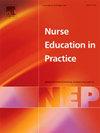Midwifery students’ experiences after participation in the SimBegin® facilitator course
IF 3.3
3区 医学
Q1 NURSING
引用次数: 0
Abstract
Aim
To explore midwifery students’ experiences from participating in a level 1 facilitator course, and the maintenance of simulation-based activities.
Background
Student-led simulation is a collaborative learning method where peers engage in simulation training. SimBegin® prepares learners to lead a pre-designed scenario and facilitate debriefing based on reflection. The course with generic scenarios and course leaders from SAFER/Laerdal was piloted for midwifery students in autumn 2022. In 2023 the e-learning was translated into Norwegian, scenarios were given a midwifery profile, midwifery teachers became course-leaders and SimBegin® was implemented in the Master of Midwifery curriculum at the University of Stavanger.
Design
A qualitative, explorative design.
Methods
One individual (n = 1) and one focus group (n = 5) interview were conducted, and written reflections collected (n = 11) from one cohort of students (n = 20) in the pilot intervention in 2022. An additional focus group (n = 6) was organized from another cohort (n = 20). All data were transcribed and analysed using thematic analysis by Braun and Clarke.
Results
The four themes:
1. Being prepared and experiencing predictability support the learning process
2. A structured course concept enables students to adopt different perspectives
3. Maintaining and practicing Student-led simulation in accordance with SimBegin®
4. SimBegin® as an eye-opener that changed their view on simulation
Conclusion
SimBegin® enabled students to run SLS to enhance simulation training. SimBegin® promotes critical thinking and is an innovative, experimental, high-quality learning method. The learning outcome is dependent on contextual factors, knowledge, psychological safety, planning, learner involvement and support from teachers and supervisors in clinical placement.
助产学学生参加SimBegin®培训课程后的经验
目的探讨助产学学生参与一级助产师课程的经验,并维持模拟活动。学生主导的模拟是一种同伴参与模拟训练的协作学习方法。SimBegin®准备学习者领导一个预先设计的场景,并促进基于反思的汇报。该课程由SAFER/Laerdal的通用场景和课程负责人于2022年秋季在助产学学生中进行了试点。2023年,电子学习被翻译成挪威语,情景被赋予助产简介,助产教师成为课程负责人,SimBegin®在斯塔万格大学的助产硕士课程中实施。设计一种定性的、探索性的设计。方法采用1名个体(n = 1)和1名焦点小组(n = 5)访谈,收集2022年试点干预1名学生(n = 20)的书面反馈(n = 11)。从另一个队列(n = 20)中组织了另一个焦点小组(n = 6)。Braun和Clarke对所有数据进行转录和专题分析。结果四个主题:1;做好准备和体验可预测性有助于学习过程。结构化的课程概念使学生能够采用不同的观点。根据SimBegin®4维护和实践学生主导的模拟。SimBegin®让他们大开眼界,改变了他们对模拟的看法结论SimBegin®使学生能够运行SLS来增强模拟训练。SimBegin®促进批判性思维,是一种创新的,实验性的,高质量的学习方法。在临床实习中,学习结果取决于情境因素、知识、心理安全、计划、学习者参与以及教师和主管的支持。
本文章由计算机程序翻译,如有差异,请以英文原文为准。
求助全文
约1分钟内获得全文
求助全文
来源期刊

Nurse Education in Practice
NURSING-
CiteScore
5.40
自引率
9.40%
发文量
180
审稿时长
51 days
期刊介绍:
Nurse Education in Practice enables lecturers and practitioners to both share and disseminate evidence that demonstrates the actual practice of education as it is experienced in the realities of their respective work environments. It is supportive of new authors and will be at the forefront in publishing individual and collaborative papers that demonstrate the link between education and practice.
 求助内容:
求助内容: 应助结果提醒方式:
应助结果提醒方式:


